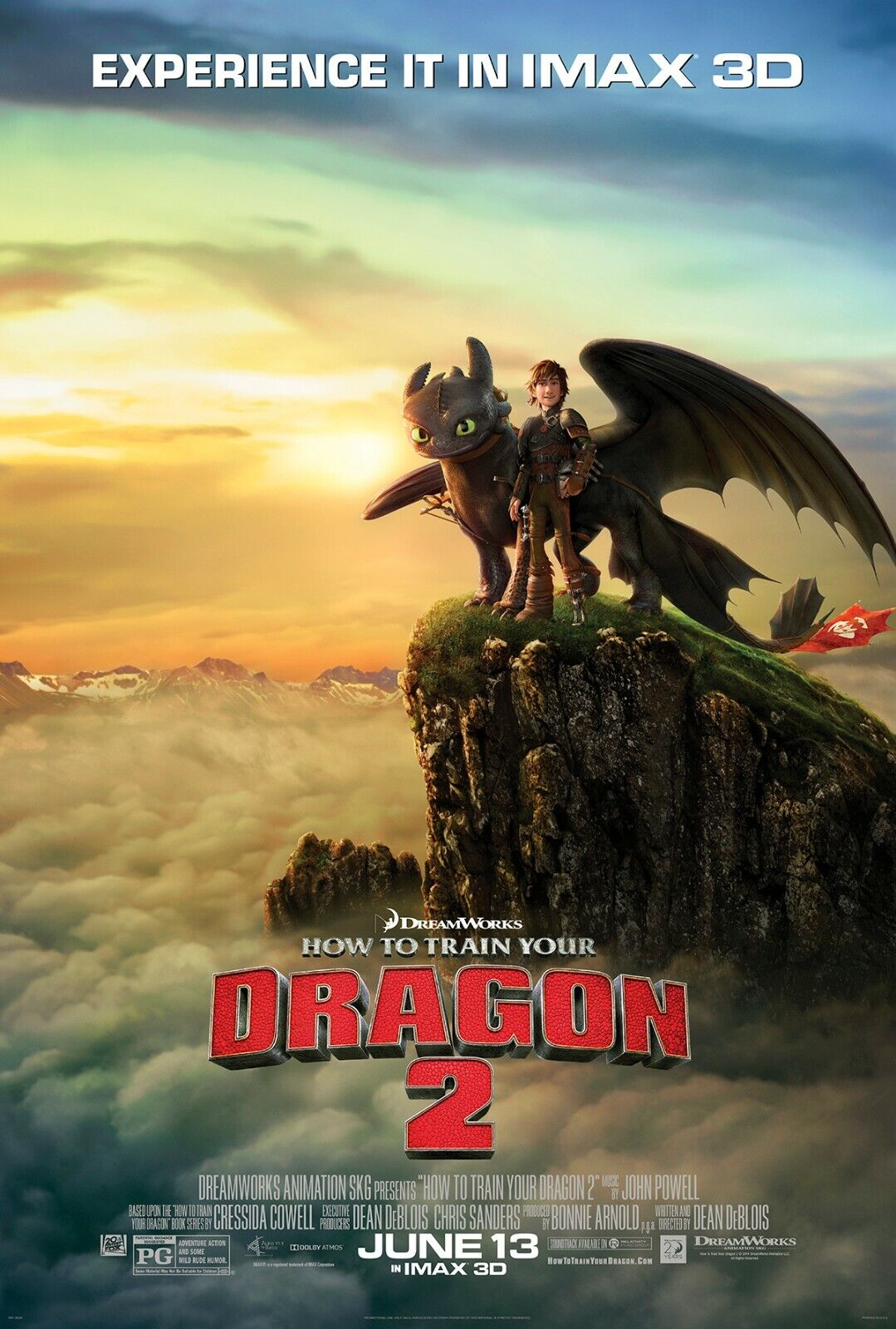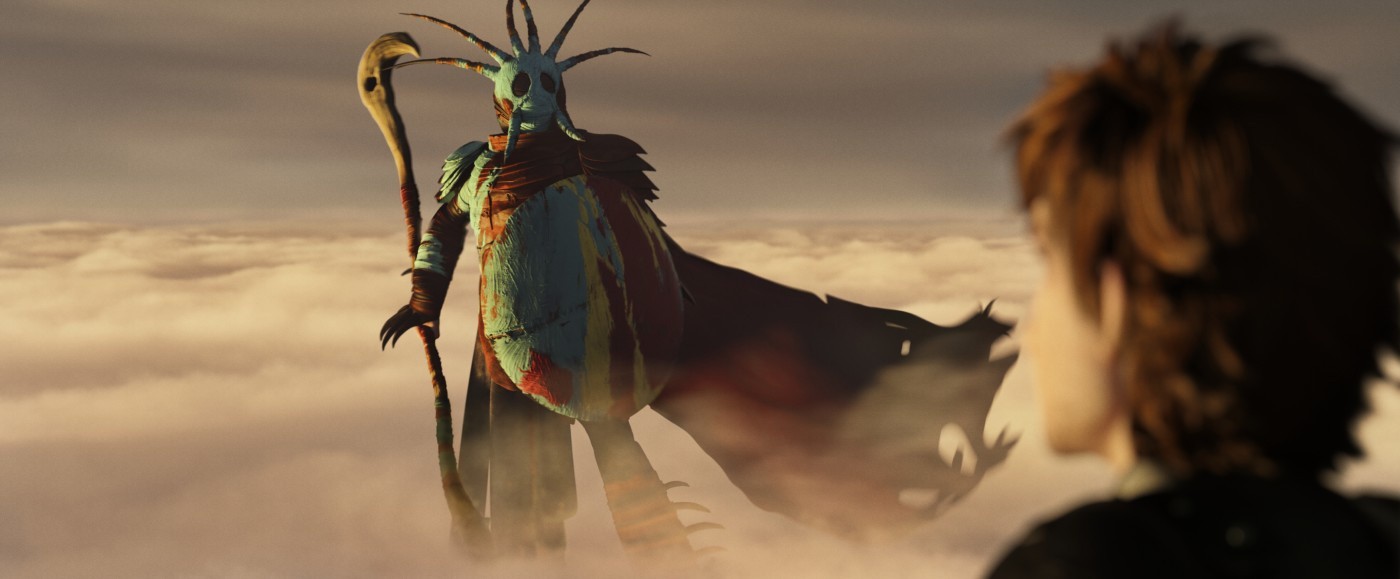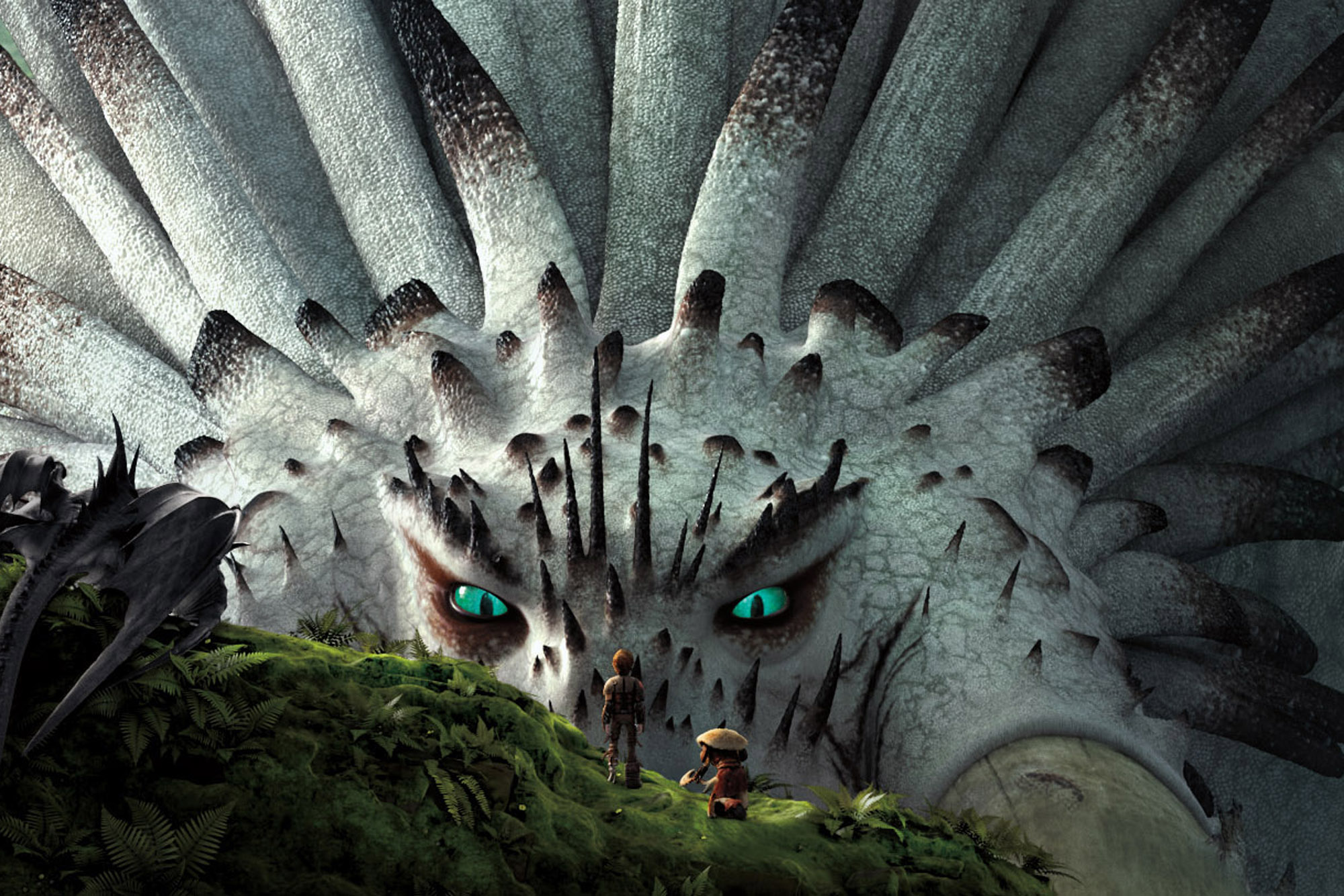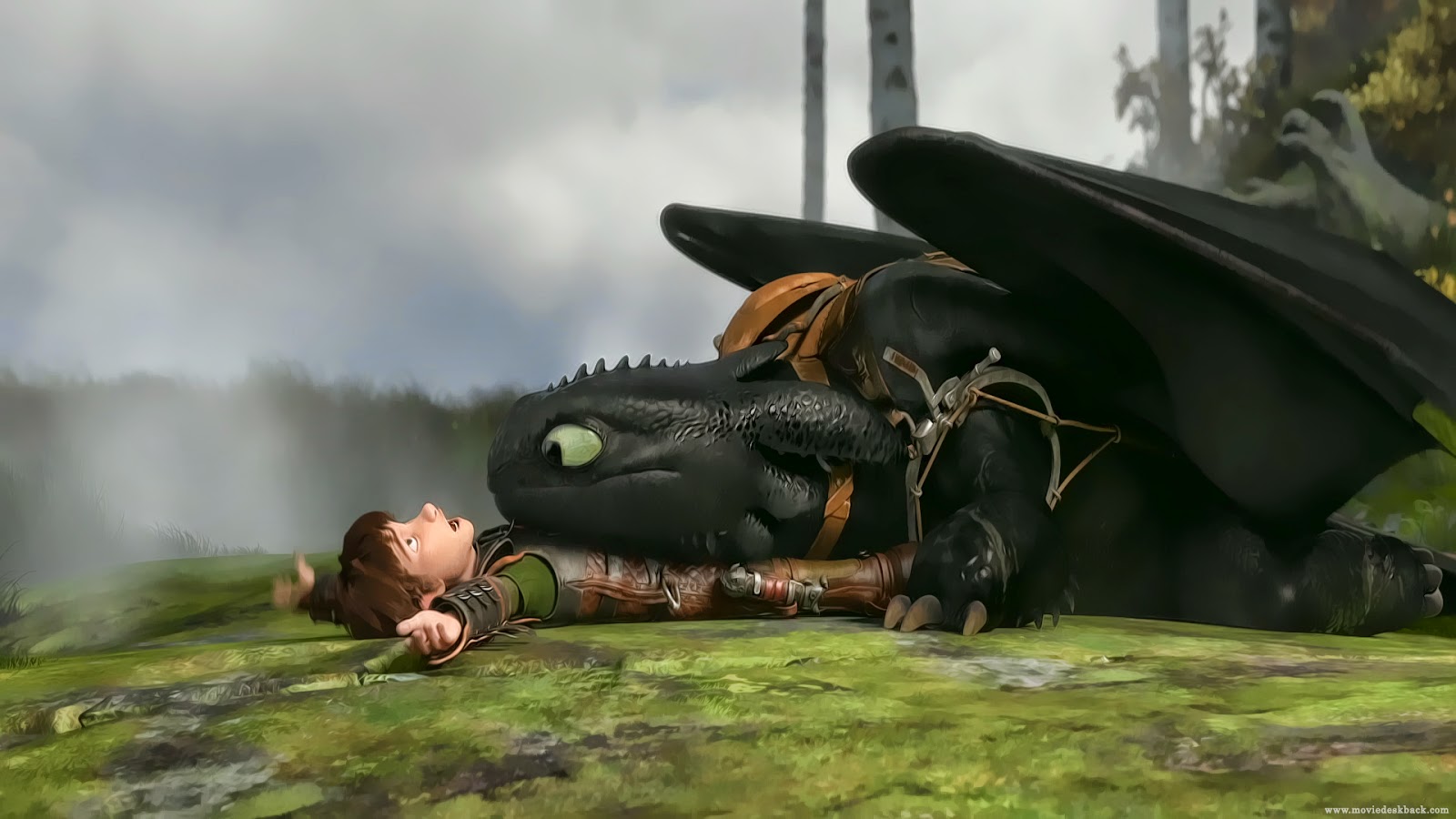Stevi Costa hops atop Toothless and rides back to Berk with How to Train Your Dragon 2, musing on the alpha myth, anti-capital punishment, knowledge vs. colonialism, how Toothless is the best boy, and her own little menagerie of loyal dragons.

Sundays are my reset day. I am much more protective of my time post-pandemic and really value having a day without obligations outside my home. On an ideal Sunday, my husband and I will hang out in the living room for hours watching movies. Our small menagerie of household pets have adopted this rhythm and also expect to spend Sundays together with us in this fashion. Our elderly, one-eyed chihuahua Tula will occupy my lap for as long as possible before grumpily moving over to her donut bed that sits between me and my husband on the couch. Vincent Price, our handsome tuxedo cat, will curl up on the edge of the couch by the window and snooze all day. Our teenage vampire kitty, Béla Lugosi, will claim her perch at the top of the cat tree and loom over the proceedings.
Often, I’ll glance around the living room on Sundays and wonder if the animals conformed their habits to mine, or if it is the opposite. The answer, of course, is that both things are true. To invite an animal into your home is to enter into an agreement that you will change each other’s nature.
The citizens of Berk have adopted this understanding of the Viking-Dragon relationship at the beginning of How to Train Your Dragon 2. The ideological arc of the first film moves from fearing dragons to learning to live with them. As a result, the Vikings now live in a dragon-centric culture that has quite literally expanded their world. Dragons have been incorporated into their daily lives and sporting activities and have enabled them to explore uncharted waters. Our protagonist Hiccup and his faithful dragon Toothless now take to the skies to expand human knowledge of dragonkind by flying to new islands, mapping them, and noting any dragon species they discover there. Hiccup would much rather follow his scientific impulses than take up his father’s offer to become Berk’s next chief. Politics doesn’t interest him. It would tie him to Berk when he’d truly prefer his freedom embodied in the new flight suit Hiccup has engineered for himself in this film. After leaping from the back of his dragon, the suit allows him to paraglide for a few moments, soaring through the air unassisted. But these moments of flight are brief, and Toothless must always rush to catch Hiccup when he drifts off course or crash lands. The dragon’s expressive eyes seem to convey a sense of watching a dog walk on its hind legs anytime Hiccup soars ahead in front of him. Hiccup would also prefer to continue exploring the world with Toothless, documenting the natural habitats of dragons as a naturalist would. Being a leader of men isn’t for him. He’s got science to do.
While out exploring, Hiccup, Astrid, and their dragons are captured by poachers who are gathering dragons for the warlord Drago Bludvist’s dragon army. The poachers’ handsome leader Eret, Son of Eret, accuses the Berkian dragonriders of stealing the last batch of dragons they had rightfully poached. Hiccup defends himself against this accusation and manages to escape with Astrid and the dragons. They return to Berk to warn Stoic of Drago’s plan, and Stoic offers some backstory on his last encounter with Drago—one which led the entire village of Berk to believe that dragons were fearsome killing machines that must be destroyed. Hiccup insists that if he could change Stoic’s mind about dragons, he could do the same with Drago. “Men who kill without reason cannot be reasoned with,” his father warns.
Hiccup doesn’t listen to this advice, of course, and sets out to find Drago, hoping to talk him down from both starting a war with Berk and poaching wild dragons. While in the air, he encounters a mysterious dragonrider who captures him and knocks Toothless out of the air and into the icy fields below. Knowing that Toothless cannot swim, Hiccup begs the rider to let him go back for his dragon. The rider charges forth, and Toothless struggles to gain purchase on a tiny piece of ice, descending into the vast black ocean below—a sight which, although I have seen this movie before, absolutely broke me because Toothless is such a good boy and nothing bad should happen to him ever. Hiccup is deposited in a cave, surrounded by hundreds of dragons. He calms them all with his arsenal of dragon-training techniques, which mystify the other dragonrider. Hiccup asks again if he may go back for his dragon, only to have Toothless deposited safely at his feet moments later. His hackles raised, Toothless is ready to protect Hiccup from the stranger, only to be immediately subdued by the mystery rider’s own skillful dragon taming techniques. When the mysterious rider recognizes a faint scar on Hiccup’s chin, she reveals herself to be his mother, Valka, who was “killed by a dragon” when he was just an infant.
Valka, it turns out, has been alive this whole time, living on an island of dragons governed by one of the oldest and rarest dragon species, the Bewildebeast. The island is beautiful and lush, full of greenery, waterfalls, and an abundance of fish. She is absolutely thriving there, and so are thousands of different dragon species. When Hiccup asks her why she never came home, she tells him the truth about the night she “died.” The dragon that encroached upon her son’s crib was only looking at him with the curiosity any mother would show to a child; it only scratched his chin because it was startled by Valka’s presence. And when Valka drew her sword to kill the dragon, she came face to face with the beast and couldn’t follow through. “This wasn’t a vicious beast,” she realized, “but a gentle, intelligent creature whose soul reflected my own.” It is in this moment of mutual realization that the dragon carries Valka off. The longer she stayed among the dragons, the more she solidified her belief that she could not live in a society that prioritized violence over peaceful understanding. In short, this woman decided she would rather live with thousands of literal dragons than ever speak to a man again. She chose the bear. (Girl, same.)
I find the HYTYD films compelling not only because they are beautifully animated, but because they are good stories with interesting characters who grapple with complex ideas. That I have a heart for animals perhaps endears them to me further. (Is this my fourth animal-centric film review for this website?) I grew up in an adopt-don’t-shop household. Every animal that has come into my life came either from a shelter, the street, or a neighbor’s backyard. I love creatures that other people have neglected or those which may be hard to love. This is a philosophy I also perhaps unconsciously apply to humans. My mother always complimented me for my choice to befriend people that others might not approach, and my life is richer for generously loving the world’s weirdos. HYTYD certainly reinforces my worldview in the end. I am the choir to which it is preaching. But I nonetheless think that it does so in a way that doesn’t feel overly didactic—even for a film for young audiences. It lets the characters hold viewpoints that feel “earned” and nuanced. By introducing new characters like Valka and Drago, the ideological world of HYTYD expands as Hiccup’s physical world expands.

Hiccup may not think of himself as a politician, but by the end of the first film, he has changed the very fabric of his world by introducing a new idea that leads to peace and prosperity. Valka could have made the same choice and, perhaps, returned after only a few years away to share her new knowledge of dragons with the village—potentially ushering in New Berk sooner. But she doesn’t, writing off humankind entirely. She remakes her life as an ally to and protector of dragons, going so far as to become an ecoterrorist. It’s Valka who liberated the dragons from the poachers with the help of the Bewildebeast, who spits the ice crystals left behind on the poachers’ ship. Her distrust of humanity is fortified by the existence of these poachers and their aim to remove dragons from their natural habitats and conscript them as weapons in human wars, which she knows to be Drago’s mission. She believes in the protection of the natural world, and in a non-anthropocentric world view.
The warlord Drago Bludvist believes not only that animals are meant to be dominated, but that humanity should also be. He promises other Viking clans protection from dragons if they will pledge to serve him, and turns his dragon armies on them if they refuse. His position is that of a colonizer, and the film makes no attempts to humanize this kind of villainy. Drago’s a bad dude. His understanding of the world stands against everything New Berk has become, and it was even extreme by the standards of Old Berk. And it is certainly the opposite of Valka’s radical eco-politics.
It is interesting to me that the film separates out Hiccup’s scientific leanings as a dragon naturalist and budding engineer from the colonizing impulses of Drago Bludvist. Scientific exploration was employed as a tool of colonization, but the nuance HYTYD2 offers lies in the impulse behind it. Documenting knowledge expands the world for the good of both human and dragon kind. Conquering shrinks it through death, destruction, and diminishing resources.
It is a little weird to make this point in a story about Vikings, who were colonizers, and to do so by creating a villain whose animation style draws on a lot of stereotypes about people of color (particularly Middle Eastern people) and is also voiced by the only Black actor in the cast. It is also a little weird that the poachers are seemingly racialized through their facial tattoos, which draw from Maori tradition and therefore cue me to read them as Pacific Islander, even though they are voiced by white actors. To be clear, I see no issue with actors of color voicing white characters. (America Ferrara voices Astrid, and her gravelly voice is perfect for this rough and tumble girl.) To say that a voice “sounds” like a particular race is to espouse a racist idea (as voices sound all kinds of different ways and the shape of one’s larynx has nothing to do with race). But if a character is drawn as a person of color, that role should ideally be voiced by a person of color for the same reason white actors shouldn’t wear black/brown/yellow/redface to play people of color. I love Djimon Hounsou and wish I saw him in more films. I think his vocal performance as Drago is great. What’s tricky about the voice casting here is that none of these characters are actually people of color, but the animators have chosen to employ both real and stereotypical traits from actual non-Viking, non-white cultures to code them as villainous others. That’s not great, and it is the chief flaw of the HYTYD series.
Perhaps that flaw is borne of the series itself adopting Hiccup and Valka’s fascination with dragons as the driver of the story. Certainly, the films are interested in making the dragons extremely easy to fall in love with—especially Toothless, the best boy in the world. Like Valka, we see our souls reflected in Toothless’s eyes. We identify with the dragon, the subject of the film’s central ideological conflict, and through the dragon’s eyes we are guided to understand with which perspectives we should align ourselves.
Hiccup remarks early in the film, “Once you earn a dragon’s loyalty, they will do anything for you.” His comment speaks to the bond he shares with Toothless, and that which all of the Berkians now share with the dragons they have invited into their homes and social order. This comment guides our understanding of Toothless’ care for Hiccup, his need to rush to the boy’s aide every time he soars off course. Hiccup also quips about it later with Valka when he explains how came to find and train his dragon. He hurt Toothless, but ultimately saved him and mended his wounds. Later, when it was the dragon’s turn to save the boy, he couldn’t save all of him, leaving the pair with matching amputations. Hiccup and Toothless are physically equals, and their mutual limb differences are a synecdoche for the care, respect, and loyalty they have to one another.
When Hiccup tells his long-lost mother about his plan to change Drago’s mind and convince him to release his dragon army, Valka cautions against it. Drago’s dragons won’t be easy to train, she explains, because “good dragons under the control of bad people do bad things.” This aphorism is why she spends her time liberating dragons from poachers. It is easier to simply save the dragons than convince an unreasonable person to change their ways. The warning she issues to her son proves prescient, as the film’s dramatic climax involves Bewildebeasts and their power to coerce the will of other dragons. On Valka’s island, the Bewildebeast is the “alpha” dragon, using his powers of will to provide for the other dragons and ensure their care. Drago’s Bewildebeast operates differently. He is a good dragon under the control of a bad person. He does bad things, namely telepathically coercing dragons to kill humans.

After Valka’s gentle Bewildebeast dies in a battle against Drago’s, the rest of the dragons fall under the more bellicose Bewildebeast’s sway—including Toothless, who is instructed to turn on his best friend Hiccup. Hiccup tries to talk Toothless out of this, and sometimes seems to succeed. We literally experience this moment through the dragon’s eyes: Hiccup appears hazy and occluded when under the Bewildebeast’s control, and clear when Toothless’ own will breaks through. The Bewildebeast’s power over Toothless is too strong, though, and he blasts a blue flame toward Hiccup. At the last moment, Stoic intervenes and takes the hit. He is killed immediately. Toothless snaps out of the Bewildebeast’s spell and realizes what he has done. He tries to comfort Hiccup, to apologize, but Hiccup sends him away—allowing Drago to conscript him into his dragon army, along with the rest of the dragons on Valka’s island and all of those belonging to the Berkian dragonriders who have come to Hiccup’s aide.
Toothless is a good dragon, and he has done a bad thing under the control of a bad person.
This is heartbreaking for many reasons. It is a tragedy for Hiccup to have just reunited with his mother, only to lose his father. And it is painful to be betrayed by a friend—even when that friend isn’t human. I have been scratched by my cats. I have been nipped by my dog. And every time I feel a little betrayed because I am only trying to care for them and I’m sorry they don’t like having their nails cut or taking medicine but this is the agreement into which they entered when they decided they wanted to stay in a house and live in abundance instead of scarcity! But my feelings of betrayal are always short. I know they don’t mean it.
When an animal attacks a human, though, our social order commands that the animal is unfit to live among humans and must be put down. I could deliver an entire lecture on the public executions of “killer elephants” (and I have!) to support this point, but one might more immediately think of the way in which “bully breeds” are branded as “bad dogs” because they have been trained to participate in illegal dog fights, or guard junk yards, or otherwise act as attack dogs. As a result of this branding, many bully breeds end up in high-kill shelters—even if they are dogs that have done nothing wrong. It is simply the actions of bad people that have condemned entire breeds of dogs to death. But in actuality, bully breeds are extremely loyal animals. Under the care of the right people, they are nothing but sweethearts. So when I think about an animal killing a human being, I am not sure the “eye for an eye” punishment we dole out to that animal is necessarily warranted. If we strive for restorative justice for humans, we should consider extending that principle to the animals we live with and among. Loyalty can be manipulated, as Hiccup learns in this film, but it is not the animal’s fault. And because HYTYD is nothing without the core relationship between Hiccup and Toothless, the dragon is spared the fate that humans typically apply to animals who kill. I appreciate this anti-capital punishment move on the part of the filmmakers.
Hiccup and company are stranded without their dragons, but Valka reminds them that baby dragons don’t listen to anyone and so did not follow the Bewildebeast’s commands. The Berkian dragonriders and now-reformed poachers ride these adorable babies back to Berk, where Drago has begun his raid on the village. Once there, Hiccup reunites with Toothless and forgives his dragon. “I know you didn’t mean to do that,” he says. It is almost as if this act of empathy is what frees Toothless from the Bewildebeast’s control. With his trusty dragon back by his side, Hiccup confronts Drago, but the warlord is steadfast in his convictions and commands the Bewildebeast to attack. Toothless leaps to Hiccup’s rescue and is encased in ice. From a screenwriting perspective, this is a great payoff for the earlier scene in which Toothless struggled with the ice floes and for the many times the dragon has come to the boy’s rescue. It seems that this might be the dragon’s ultimate sacrifice, but as a blue glow emanates from the ice, Toothless shatters his icy prison and emerges unharmed, growling resolutely at the Bewildebeast. “He’s challenging the alpha!” Hiccup cries.

“Alpha” animals are a myth. Only in captivity do animals, specifically wolves, force dominance on others. In the wild, wolf packs are not hierarchical. Even though the film continues to use the language of the alpha myth, it actually shows the difference between behavior in captivity and behavior in the wild through the two Bewildebeasts. Valka describes the arrangement on her island as all creatures living “under [the] care” of the Bewildebeast. Drago uses the word “control” when describing the captured dragons that follow his Bewildebeast. In captivity, hierarchy emerges. In the wild, it doesn’t. But Hiccup has earned Toothless’ loyalty, and earning that loyalty means that Toothless will protect his best friend at all costs. So, driven by this bond, he challenges the Bewildebeast, breaking the larger dragon’s sway over the others, who then rally around Toothless to defeat their captor, who rides off with Drago on its back.
With the villain defeated and Stoic dead, it is time for Berk to rebuild. Hiccup takes the throne he had reluctantly denied before, and Toothless is regarded as the “alpha dragon” by all, completing the standard princely coming-of-age narrative upon which this film hangs much grander, more interesting ideas about the human-animal relationship. Now that dragons and humans live with one another peacefully in Berk, Valka agrees to return there. Her son has proven to her that humans can move away from logics of dominance and violence, and she can live in a world that is led by a man who embraces compassion and reason above all else.
This rewatch inspired me to look into the source material for HTTYD2, which I had never bothered to research before. I was curious about the ideas the films contain and how they manifested in the source material. I didn’t get so far as reading one of Cressida Crowell’s middle-grade novels, but I did read all of the plot summaries on scholarly journal Wikipedia and I am fairly confident that none of the things I admire about the films come from the novels. That’s all from screenwriter and director Dean DeBlois (who is the sole hand on HTTYD2, but co-directed and co-wrote the first film with Chris Sanders, along with co-writer Will Davies). DeBlois also directs the third installment in the series, which I look forward to writing about while crying in 2029.
As I write this piece, though, Tula is snoozing on her bed in my office, with Béla napping nearby on the pink velvet chair she has claimed as her throne. Vincent is in our bedroom, snuggled up on our bed. I like to work from home because they are here. I build my day around their needs. My first act upon waking is to feed them. While I brew my coffee, I spoon out wet food into their little bowls, topping the cat’s food with real actual meat because I am a sucker and they conned me into it, gently cutting up the dog’s smelly chunks of expensive kidney diet food with a spoon so she can better chew it with her remaining teeth. And when I sit down to drink my coffee, Vincent comes to cuddle me. I stare into his beautiful green eyes as he purrs and I think: how good it is to have earned the loyalty of these dragons.
— Stevi Costa

